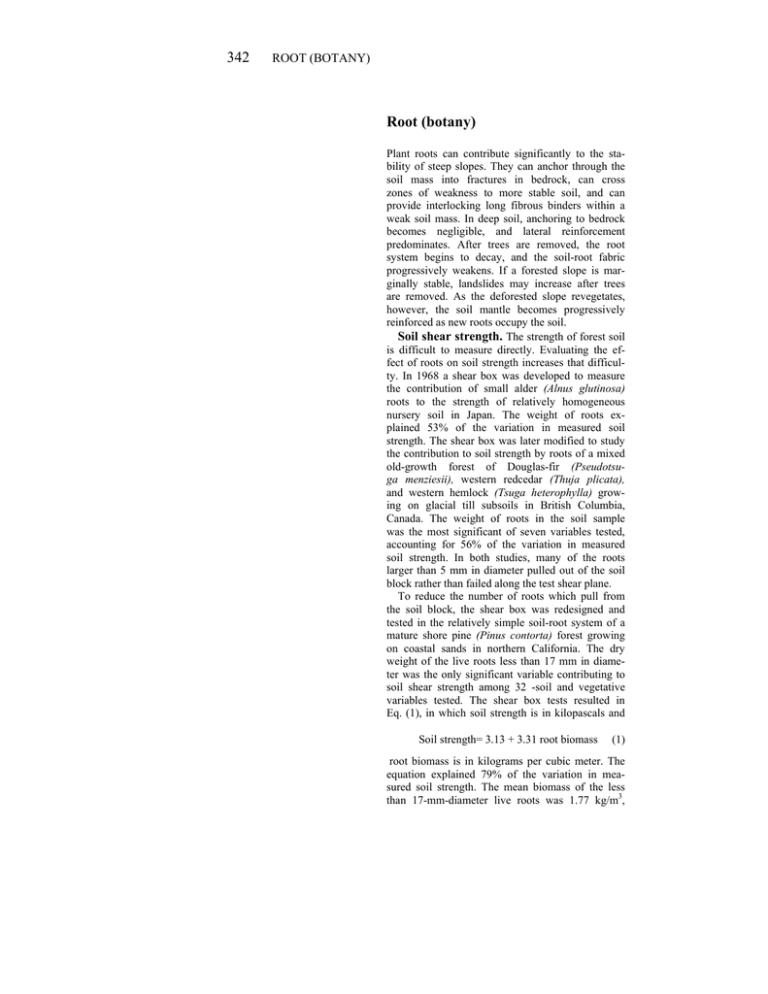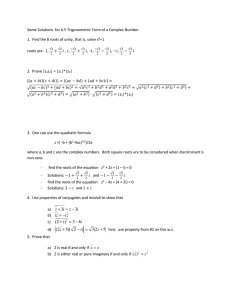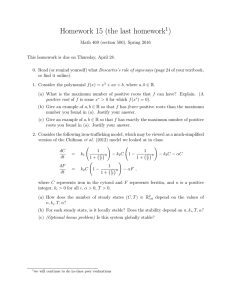342 Root (botany) ROOT (BOTANY)
advertisement

342 ROOT (BOTANY) Root (botany) Plant roots can contribute significantly to the stability of steep slopes. They can anchor through the soil mass into fractures in bedrock, can cross zones of weakness to more stable soil, and can provide interlocking long fibrous binders within a weak soil mass. In deep soil, anchoring to bedrock becomes negligible, and lateral reinforcement predominates. After trees are removed, the root system begins to decay, and the soil-root fabric progressively weakens. If a forested slope is marginally stable, landslides may increase after trees are removed. As the deforested slope revegetates, however, the soil mantle becomes progressively reinforced as new roots occupy the soil. Soil shear strength. The strength of forest soil is difficult to measure directly. Evaluating the effect of roots on soil strength increases that difficulty. In 1968 a shear box was developed to measure the contribution of small alder (Alnus glutinosa) roots to the strength of relatively homogeneous nursery soil in Japan. The weight of roots explained 53% of the variation in measured soil strength. The shear box was later modified to study the contribution to soil strength by roots of a mixed old-growth forest of Douglas-fir (Pseudotsuga menziesii), western redcedar (Thuja plicata), and western hemlock (Tsuga heterophylla) growing on glacial till subsoils in British Columbia, Canada. The weight of roots in the soil sample was the most significant of seven variables tested, accounting for 56% of the variation in measured soil strength. In both studies, many of the roots larger than 5 mm in diameter pulled out of the soil block rather than failed along the test shear plane. To reduce the number of roots which pull from the soil block, the shear box was redesigned and tested in the relatively simple soil-root system of a mature shore pine (Pinus contorta) forest growing on coastal sands in northern California. The dry weight of the live roots less than 17 mm in diameter was the only significant variable contributing to soil shear strength among 32 -soil and vegetative variables tested. The shear box tests resulted in Eq. (1), in which soil strength is in kilopascals and Soil strength= 3.13 + 3.31 root biomass (1) root biomass is in kilograms per cubic meter. The equation explained 79% of the variation in measured soil strength. The mean biomass of the less than 17-mm-diameter live roots was 1.77 kg/m3, ROOT (BOTANY) which represented 64% of the total root biomass. Adding more variables did not significantly improve the regression equation. Strength of individual roots. Roots become stronger as they become larger; the logarithm of root shear strength is closely related to the logarithm of the diameter of the root. The strength of roots also varies between species. In Canada small Douglas-fir roots are about 10% stronger than western redcedar roots. In the Soviet Union poplar (Populus deltoides) roots are the strongest, followed by birch (Betula pendula), oak (Quercus robur), linden (Tilia cordata), and spruce (Picea abies). Poplar roots are about 40% stronger than spruce roots. Tree roots are estimated to be 1.5-3 times stronger than the roots of grassy plants of the same diameter. In northern California the roots of brush, such as Ceanothus velutinus and Sambucus callicarpa, are about twice as strong as the roots of conifer trees, such as Abies concolor, Pinus lambertiana, and P. ponderosa. Roots and soil strength. Roots increase the strength of soils. The forces involved in the failure of a section of bank along the Moscow River in the Soviet Union were evaluated. The size and number of roots protruding from the wall of the collapsed soil block were measured. The tensile strength of linden roots was determined in the laboratory. The total force required to break the soil mass reinforced by linden roots was calculated to be about 137 metric tons, of which 130 tons were required to break the roots and 7 tons to tear the sandy loam soil mass from the bank. Breaking the linden roots took 95% of the total force, although the total cross-sectional area of all the roots constituted less than half a percent of the wall area of the collapse. It has been calculated that the root network accounted for 71% of the shear strength at saturation of glacial till soils on 35° slopes in British Columbia. It was observed in Sweden that an imposed load may be 70% greater before soil rupture in soils with a root network than in soils without roots. Slope stability problems will likely develop as the tree root system decays after timber cutting on steep slopes where the predominant strength is contributed by the binding action of the roots. As the root system decays following deforestation, the relative reinforcement by the roots will decline (Fig. 1). Within 2 years after deforestation, about 50% of the original root reinforcement is lost and 90% is gone within 9 years. The rate of strength loss varies according to species, root size, and the activity of decay organisms. Small roots decay most rapidly, while large decay-resistant roots may remain in the soil for decades. For example, intact roots have been found greater than 15 cm in diameter from western redcedar trees which had been cut 50 years earlier. However, redcedar roots 1 cm in diameter had lost about 50% of their tensile strength within 5 years of cutting. Douglas-fir roots decay more rapidly than redcedar roots, and the rate of decay is related to geographic location. The strength of 1-cmdiameter Douglas-fir roots decreased by about 50% within 3 years after cutting in coastal British Columbia. It was found that 50% of the Douglas-fir 343 Fig. 1. Conceptual model of changes of relative root reinforcement with time after deforestation for residual roots from the cut forest and for new roots from the regenerated forest. Net reinforcement is the sum of reinforcement by the cut forest and the regenerated forest. roots 1 cm in diameter decayed within 1 1/2 years in the Rocky Mountains, and the same proportion was gone within 1 year in coastal Oregon. About 90% of the Rocky Mountain roots decayed in 12 years, whereas 90% of the Oregon roots were gone in less than 5 years. As vegetation reoccupies the deforested area, new roots begin to progressively reinforce the soil. For example, in Fig. 1, about 14 years are required until the new forest provides 50% of the root reinforcement supplied by the original forest before cutting, and 23 years until the soil in the deforested area returns to the strength of that in the uncut forest. The actual rate of soil strength recovery can vary, and depends on many more environmental variables than does the rate of strength loss through decay. In severe sites the recovery of root reinforcement can be lengthy. In logged mixed conifer forests in northwestern California, calculated root reinforcement in areas logged 25 years earlier was only about 40% of that in adjacent uncut areas. The net reinforcement of the soil by roots is the sum of the reinforcement by residual decaying roots of the cut trees and the reinforcement by new roots of the regenerating forest. In Fig. 1 the net reinforcement in a promptly regenerated forest reaches a minimum about 9 years after deforestation. Net reinforcement then is about 20% of that in the uncut forest. It becomes greater after 9 years, as the roots of the new forest continue to develop in the cut areas. If regeneration is delayed by 5 years, decay of the residual root system of the cut forest will continue for 5 years before the new root system begins to add strength. The net soil reinforcement will then reach a minimum which is substantially lower than in areas where regeneration is prompt. The minimum net reinforcement with a 5-year delay in revegetation occurs 12 years after logging, and is only about 7% of that in the uncut forest. 344 SALAMANDER Fig. 2. Conceptual representation of the interaction between seasonal pore water pressure and the loss and recovery of root reinforcement and the effect on safety factor. Safety factor is an index of relative stability of slopes and is the ratio of available shear strength to shear stress. Stability of slopes. Roots help stabilize steep slopes. Engineering stability analyses have been applied to slopes with and without roots. A safety factor-defined as the ratio of the available shear strength to the shear stress-provides an index of the relative stability of slopes. A slope with a safety factor of less than 1.0 cannot remain stable and must fail. Strength of a soil or resistance to failure can be described as a modification to Coulomb's law, Eq. (2). Bibliography: E. R. Burroughs and B. R. Thomas, USDA For. Serv. Res. Pap. INT-190, 1977; C. L., O'Loughlin, Can. J. For. Res., 4:107-113, 1974; T. H. Wu, W. P. McKinnell III, and D. N. Swanston, Can. Geotech. J., 16:19-33, 1979; R. R., Ziemer, Int. Ass. Hydrol. Sci. Publ. 132, 1980. s = ( c + r ) + σ tan φ where (2) s =soil shear strength c = effective soil cohesion r = apparent cohesion due to roots σ = effective normal stress φ = effective internal friction angle On a given slope not subjected to excavation, the two principal effects of deforestation are modifications to the root strength parameter r and the effective normal stress σ through changes in the saturated soil water regime or pore water pressures. Consider a case where all other factors are held constant and the safety factor equals 1.0 when the relative root reinforcement is 0.15 (Fig. 1). Then, if prompt regeneration follows deforestation, the net reinforcement always remains above 0.20, and the slope would not fail. However, if regeneration is delayed 5 years, the net reinforcement would fall below 0.15 from 8 years until 16 years after deforestation, and the slope would fail 8 years after cutting. All factors, however, do not remain constant. Pore water pressures change seasonally in response to precipitation, and are often the driving mechanism which ultimately leads to slope failure (Fig. 2). In this example, the slope would not fail because of either seasonal pore water pressures or loss of root strength alone. When both factors are considered together, the loss of root strength lowers the safety factor to a level that a moderate change in pore water pressure would result in slope failure. For background information see FOREST SOIL; ROOT (BOTANY) in the McGraw-Hill Encyclopedia of Science and Technology. [ROBERT R. ZIEMER]





